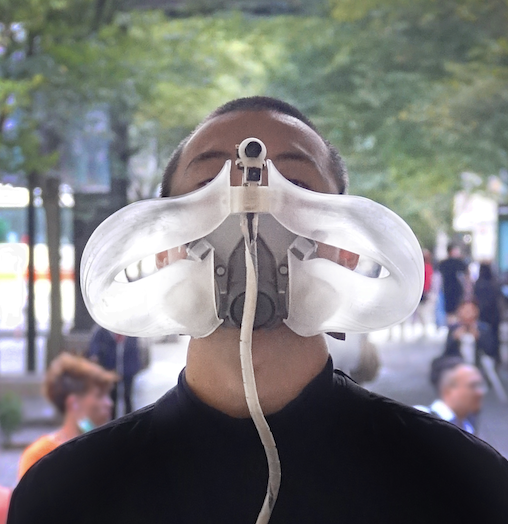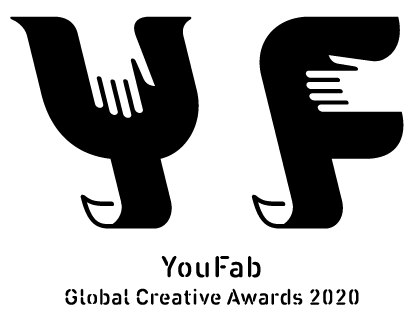Small Robot-an extension of skin Visual Awareness
Motor Actuator Sensory Substitution
How it work
Understand_V.T.S.HAOS
-
作品タイトル(日本語)
無題 _ V.T.S.HAOS
-
作品タイトル(英語)
Understand_V.T.S.HAOS
-
制作物のコンセプトを記載してください。
Understand_V.T.S is an interactive installation that substitutes senses, conducting the experiment in which the possibility of the cooperation between our brain and artificial algorithms are assessed. Control the robot that wanders about the surroundings of you. Eventually, your brain will manage to recognize the surroundings. Unlock a new pattern with your tactile cognition, as a human enhancement experiment.
How to create a new form of Art Future with AI?
Human brains are quite plastic. Or perhaps we should put it another way, of great plasticity. With that plasticity, we humans are free to interchange between senses. Thus, what we perceive with our sense organs can be transformed into another sensory signal: to see with our tongues, or to listen with our touch sensory, so to speak. I am expanding the capabilities of sensory substitution technology in the field of art, and proposed a different application basis rather than the current sensory substitution—mixed real-time object detection to reach the world and open a new way to re- understand art. Explore a new way to utilize the plasticity of human brains to process tactile signals and recognize objects at the same time, thus achieving the goal of the cooperation between human and AI, unlocking a major human enhancement future for non-implantable devices.
Discover A New Method for HCI and Experiment with A New Type of Art Experience
This kind of interactive sensory substitution installation, which is carried out through the creation of new neurons in brains, serves as an approach to data physicalization.
Not only does it enhance our cognition, but it enables us to re-understand everything with a low- cost human enhancement that does not require surgery.
This technology is generating new ways for us to experience art by different sensor cognition.
“A non-exhaustive panorama “has always been vision-to-touch sensor substitution’s problem for helping the blind. It also provides a rich perceptive experience. I introduced an object recognition system -- YOLO v3 to develop a tactile language.
To sum up, it tries out how well our brains(natural) work with AI (man-made).
How does this kind of Human Artificial Intelligence Cooperation Expand the art world?
As an experiment of a new mode of art, it provides different sensory perspectives and sends us into the unchartered territory of artistic experience. As long as you attach a device, you can use your skin to experience & understand any data that can be observed. Despite the fact that the ways we perceive art are still somewhat limited, with a modest amount of learning it will know no bounds.
Is What We Think of Reality Really Just the Best Prediction of the Brain's Electronic Signals?
How do we start over by dismantling the pattern of perception built by our visual system? Once we make a fresh start for our senses and perception, can the existing forms of politics be replaced by new ones? Or, even, can we sense the reality like never before? Or what if, the so called “reality” was never a thing?
These are the questions that I’ve been trying to figure out with this very work.
The world perceived by our sense is just the tip of the iceberg
However, throughout the course of history, we humans tend to establish our connections with the world based on that tip of the iceberg we are aware of.
However, we can still feel or sense the world since our bodies allow as to sense and to have feelings about our surroundings.
The fact is, we do live in the world. Therefore, the rejoicing, ecstasy, distress, helplessness, pain, exist all because of the world make us feel and sense.
The possibility of promoting human abilities through this installation may be able to realize in this beautiful world that is meaningless but must experience, and then continue to perceive, learn, feel the pain, feel love, and live. -
制作物のコンセプトを記載してください。(英語)
Understand_V.T.S is an interactive installation that substitutes senses, conducting the experiment in which the possibility of the cooperation between our brain and artificial algorithms are assessed. Control the robot that wanders about the surroundings of you. Eventually, your brain will manage to recognize the surroundings. Unlock a new pattern with your tactile cognition, as a human enhancement experiment.
How to create a new form of Art Future with AI?
Human brains are quite plastic. Or perhaps we should put it another way, of great plasticity. With that plasticity, we humans are free to interchange between senses. Thus, what we perceive with our sense organs can be transformed into another sensory signal: to see with our tongues, or to listen with our touch sensory, so to speak. I am expanding the capabilities of sensory substitution technology in the field of art, and proposed a different application basis rather than the current sensory substitution—mixed real-time object detection to reach the world and open a new way to re- understand art. Explore a new way to utilize the plasticity of human brains to process tactile signals and recognize objects at the same time, thus achieving the goal of the cooperation between human and AI, unlocking a major human enhancement future for non-implantable devices.
Discover A New Method for HCI and Experiment with A New Type of Art Experience
This kind of interactive sensory substitution installation, which is carried out through the creation of new neurons in brains, serves as an approach to data physicalization.
Not only does it enhance our cognition, but it enables us to re-understand everything with a low- cost human enhancement that does not require surgery.
This technology is generating new ways for us to experience art by different sensor cognition.
“A non-exhaustive panorama “has always been vision-to-touch sensor substitution’s problem for helping the blind. It also provides a rich perceptive experience. I introduced an object recognition system -- YOLO v3 to develop a tactile language.
To sum up, it tries out how well our brains(natural) work with AI (man-made).
How does this kind of Human Artificial Intelligence Cooperation Expand the art world?
As an experiment of a new mode of art, it provides different sensory perspectives and sends us into the unchartered territory of artistic experience. As long as you attach a device, you can use your skin to experience & understand any data that can be observed. Despite the fact that the ways we perceive art are still somewhat limited, with a modest amount of learning it will know no bounds.
Is What We Think of Reality Really Just the Best Prediction of the Brain's Electronic Signals?
How do we start over by dismantling the pattern of perception built by our visual system? Once we make a fresh start for our senses and perception, can the existing forms of politics be replaced by new ones? Or, even, can we sense the reality like never before? Or what if, the so called “reality” was never a thing?
These are the questions that I’ve been trying to figure out with this very work.
The world perceived by our sense is just the tip of the iceberg
However, throughout the course of history, we humans tend to establish our connections with the world based on that tip of the iceberg we are aware of.
However, we can still feel or sense the world since our bodies allow as to sense and to have feelings about our surroundings.
The fact is, we do live in the world. Therefore, the rejoicing, ecstasy, distress, helplessness, pain, exist all because of the world make us feel and sense.
The possibility of promoting human abilities through this installation may be able to realize in this beautiful world that is meaningless but must experience, and then continue to perceive, learn, feel the pain, feel love, and live. -
作品の素材・仕様
Size of demo equipment (height x width x height) : 200x200x120(cm)
Size of demo Space (height x width x depth) : 400x400x300(cm) -
作品の素材・仕様(英語)
Jetson Nano, Rpi Camera, Raspberrypi, Servo Motor Mg996r, 3D printing model, Dualshock 4, Aluminum extrusion
Size of demo equipment (height x width x height) : 200x200x120(cm)
Size of demo Space (height x width x depth) : 400x400x300(cm) -
作品のリファレンスURL
https://www.espoarte.net/arte/sulle-hybrids-art-e-la-centralita-della-ricerca-scientifica-e-tecnologica/
-
作品の映像URL
https://vimeo.com/375962590#
-
公式サイト、もしくはSNSのURL
Instagram : cj_3_jo
-
プロフィール情報
Lai, Jiun-Ting was born in 1994 in Taipei. A new media artist and the founder of Cognitive Savages, a new media interactive team.
He focuses on the field of Human-Computer Interaction in which he is now working on the creation of something futuristic — the Orient Cyborg. In order to create new sensory abilities and at the same time expand the existing ones, he is endeavoring to assess the possibility of the cooperation between the human brain and artificial intelligence.
He won the First Prize of the 13th Taiwan Influential Rookie Award, 2018 VISION GET WILD AWARD, Knowledge Taiwan Creativity Award, nominated for 14th Laguna Award Virtual Art finalist, and participates in 2020 Ars Electronica.ARTDomains Gallery.
He also pays attention to the impact of surveillance capitalism and how technology is changing our lives nowadays.
Now he is participating in artist-in-residence programs by Taiwan Industrial Technology Research Institute. -
参加メンバー
Independent work
Special thanks : CHAN,YUEH-TUNG for Filming
Chi Yu Yu for low price LCD 3D Printing Model -
居住国
Taiwan


